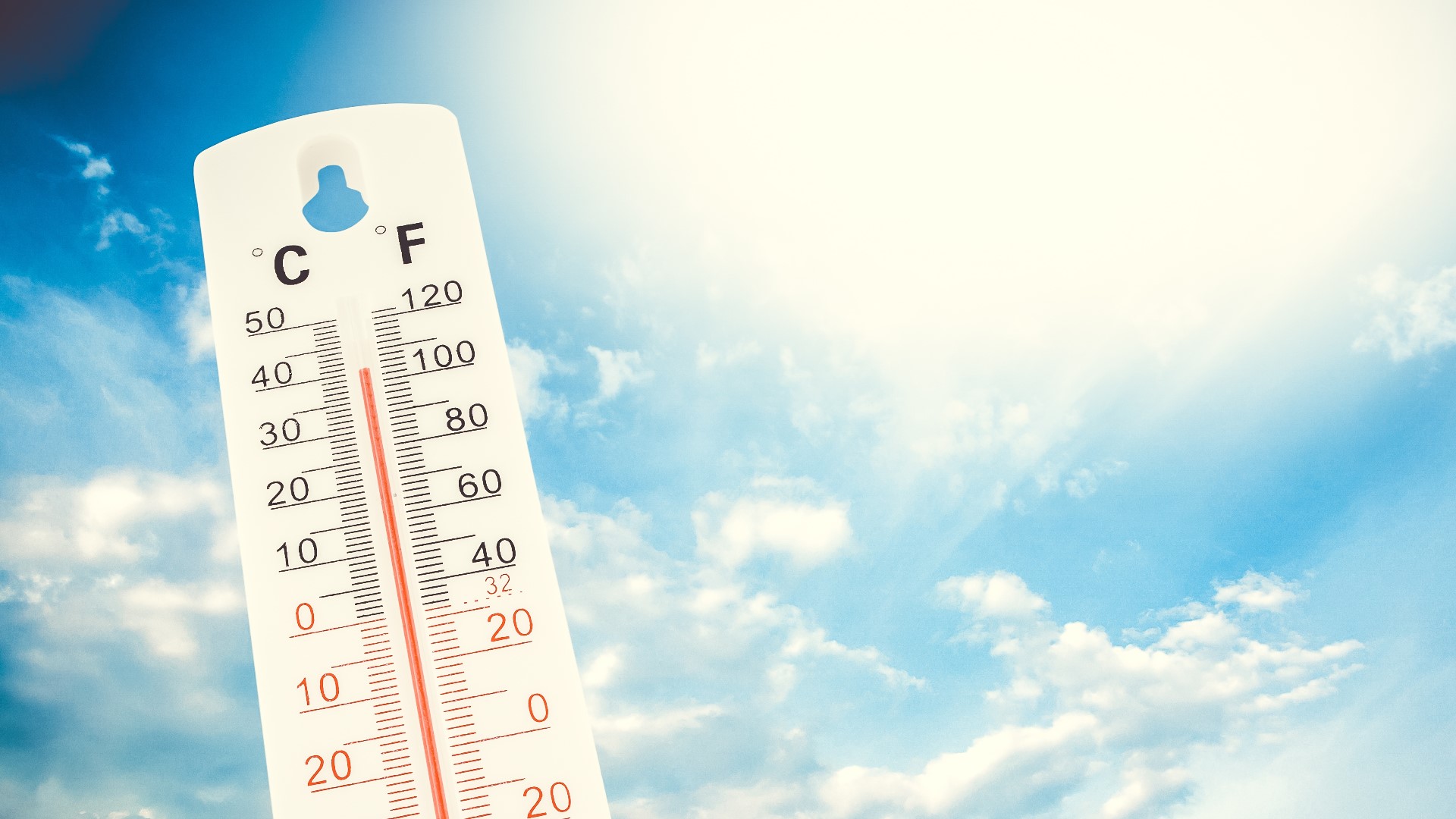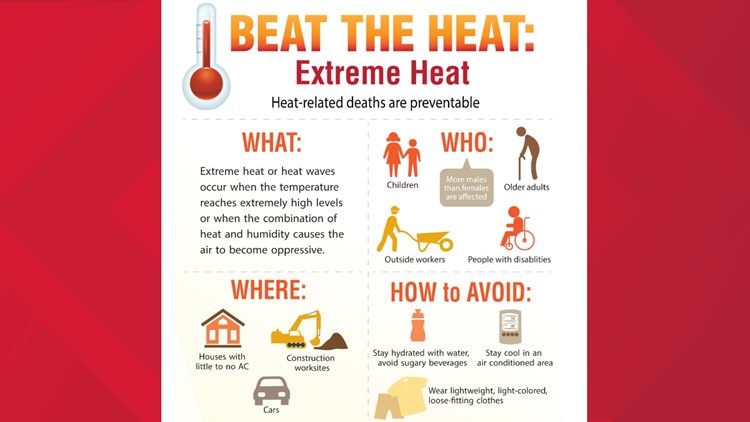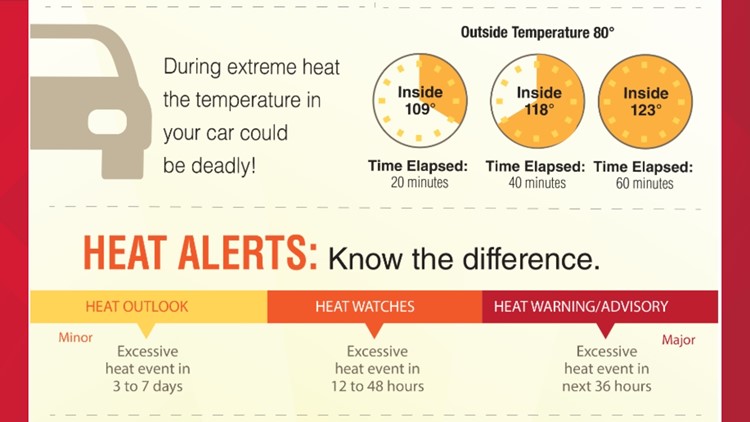SPOKANE COUNTY, Wash. —
Extreme heat is the most dangerous type of severe-weather event in the U.S., but people can take action to prepare themselves and their families for extreme heat events.
Excessive Heat Warnings are in place across the Inland Northwest for an incoming heat wave. Temperatures in the coming days will climb into the triple digits across much of the region for the first time this year. The high temperatures have the potential to break records Thursday, Friday, and Saturday.
The Centers for Disease Control and Prevention (CDC) is advising the public on how to help keep everyone safe and healthy before, during, and after extreme heat temperatures. Children, older adults, outside workers and people with disabilities are more at risk of suffering from heat-related illnesses.
Here is how to stay safe in extreme heat during this week's temperatures.
Stay cool
- Wear adequate clothing: Choose lightweight, light-colored, loose-fitting clothing.
- Stay cool indoors: Stay in an air-conditioned place as much as possible. If your home does not have air conditioning, go to a shopping mall or public library.
- Try to limit outdoor activities: Schedule outdoor activities carefully and try to only go out during the coolest hours in the morning and evening. Rest in shady areas to allow your body to recover. Cut down on exercise during the heat.
- Wear sunscreen: If you must go outdoors, protect yourself from the sun by wearing a wide-brimmed hat and sunglasses, and putting on sunscreen of SPF 15 or higher 30 minutes prior to going out.
- Do not leave children in cars: Cars can quickly heat up to dangerous temperatures, even with a window cracked open. While anyone left in a parked car is at risk, children are especially at risk of getting a heat stroke or dying.
Beat the Heat:
Stay Hydrated
- Drink plenty of fluids: Drink more fluids, regardless of how active you are. Don’t wait until you’re thirsty to drink.
- Stay away from very sugary or alcoholic drinks: These drinks cause you to lose more body fluid. Also, avoid very cold drinks as they can cause stomach cramps.
- Replace salt and minerals: Heavy sweating removes salt and minerals from the body that need to be replaced. A sports drink can replace the salt and minerals you lose in sweat.
- Keep your pets hydrated: Provide plenty of fresh water for your pets and leave the water in a shady area.
Stay Informed
- Check for updates: Check your local news for extreme heat alerts and safety tips and to learn about any cooling shelters in your area.
- Know the Signs: Learn the signs and symptoms of heat-related illnesses and how to treat them.
- Monitor those at high risk: Although anyone can suffer from heat-related illness at any time, some people are at greater risk than others. Pay attention to your neighbors and your family members, especially infants and young children, seniors
,and people with health conditions or special needs.
Signs of warming and symptoms of heat-related illness
Some heat-related illnesses include heat stroke, heat exhaustion, heat cramps, sunburn, and heat rash. Heat-related illnesses are preventable. Learn the symptoms and what to do if you or a loved one shows signs of having a heat-related illness.
Heat stroke
Heat stroke is the most serious medical condition caused by extreme heat, according to the American Red Cross. It requires immediate emergency treatment as it can result in death if the person doesn't receive immediate medical attention.
What to look for? High body temperature (103°F or higher); hot, red, dry, or damp skin; fast, strong pulse; headache; dizziness; nausea; confusion, and losing consciousness.
What to do? Call 911 right away, then do the following:
- Move the person to a cooler place
- Help lower the person's temperature with a cool or cold bath, misting, fanning or applying cool cloths, if a bath is not available.
- Do not give the person anything to drink.
Heat exhaustion
Heat exhaustion is a severe heat-related illness requiring emergency medical treatment.
What to look for? Look for heavy sweating; cold, pale and clammy skin; fast, weak pulse; nausea or vomiting; muscle cramps; tiredness or weakness; dizziness; headache and brief fainting.
What to do?
- Move the person to a cool place
- Loosen their clothes
- Put cool, wet cloths on their body, use misting and fanning, or help them take a cool bath
- Have the person sip water
Get medical help right away if:
- Vomiting occurs
- Symptoms get worse
- Symptoms last longer than one hour
- Confusion develops
Heat cramps
Heat cramps are muscle spasms, often in the abdomen, arms or calves, caused by a large loss of salt and water in the body.
What to look for?
- Heavy sweating during intense exercise
- Muscle pain or spasms
What to do?
- Stop physical activity and move the person to a cool place
- Have the person drink water or a sports drink
- Instruct the person to wait for cramps to go away before resuming physical activity
- Get medical help right away if cramps last longer than one hour.
DOWNLOAD THE KREM SMARTPHONE APP
HOW TO ADD THE KREM+ APP TO YOUR STREAMING DEVICE
ROKU: add the channel from the ROKU store or by searching for KREM in the Channel Store.
Fire TV: search for "KREM" to find the free app to add to your account. Another option for Fire TV is to have the app delivered directly to your Fire TV through Amazon.
To report a typo or grammatical error, please email webspokane@krem.com.







